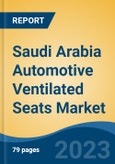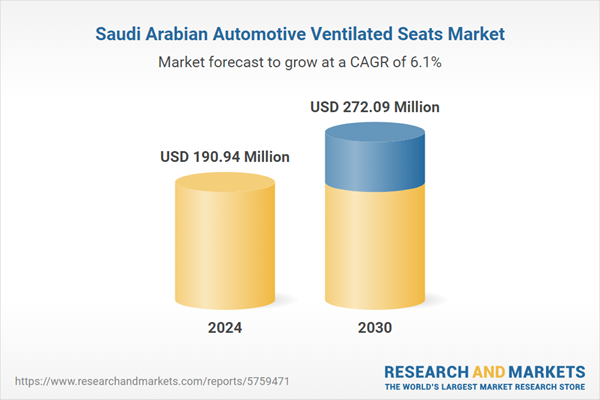Speak directly to the analyst to clarify any post sales queries you may have.
10% Free customizationThis report comes with 10% free customization, enabling you to add data that meets your specific business needs.
Emerging trends in the automotive ventilated seats market include integration with other smart vehicle systems and the use of sustainable materials. Automakers are focusing on creating seats that adapt to the occupant's body temperature using sensors and automated controls, enhancing user experience. There is also a noticeable shift toward eco-friendly manufacturing processes and materials, reflecting growing environmental awareness. Opportunities arise from expanding electric and hybrid vehicle segments, where climate control within the cabin plays a crucial role in energy efficiency. The increasing availability of ventilated seats in mid-range vehicle models is expected to further drive adoption, broadening the market beyond luxury segments.
The market faces challenges such as high production costs and the complexity of integrating ventilated seats into different vehicle models. The need for specialized components and materials elevates the cost, which may limit accessibility for budget-conscious consumers. Maintenance and durability concerns also pose obstacles, as the ventilation mechanisms require careful design to withstand long-term use without malfunction. Moreover, competing comfort technologies, such as heated and massage seats, may affect consumer preference dynamics. Addressing these challenges through innovation and cost-effective solutions will be essential for manufacturers to capitalize on the growing demand for ventilated seats in the automotive industry.
Market Drivers
Rising Demand for Enhanced Passenger Comfort
Consumers are increasingly valuing comfort as a core feature in vehicles, driving the demand for automotive ventilated seats. These seats regulate temperature, providing cooling during hot conditions, which significantly improves ride quality and reduces driver fatigue. Comfort has become a key differentiator for automakers competing in the mid to premium vehicle segments. Enhanced comfort features often translate into higher customer satisfaction and loyalty. Ventilated seats create a perception of luxury and modernity, attracting consumers who seek a blend of functionality and prestige in their cars.Manufacturers are responding by integrating ventilated seating systems as standard or optional features to meet evolving consumer expectations. This shift in consumer behavior encourages automakers to invest heavily in research and development to innovate seating solutions. As passenger expectations evolve, the comfort aspect of a vehicle increasingly influences buying decisions. This dynamic fuels continuous market growth and innovation in seating technologies.
Key Market Challenges
High Manufacturing and Installation Costs
Automotive ventilated seats involve sophisticated components such as fans, sensors, and air channels, which increase production complexity and cost. This leads to higher vehicle prices or limits ventilated seats to premium models only. Cost remains a significant barrier for mass-market adoption, particularly in budget-conscious segments. Manufacturers must balance technological sophistication with cost efficiency to make ventilated seats accessible across vehicle classes without compromising quality or durability. The investment required for research, tooling, and supply chain management further elevates expenses. This economic challenge can slow down the introduction of ventilated seats in entry-level vehicles. Cost-effective innovations and economies of scale will be critical in overcoming this hurdle.Key Market Trends
Integration with Smart Vehicle Ecosystems
Automotive ventilated seats are increasingly integrated with smart vehicle systems, including climate control, seat memory, and driver assistance features. Sensors monitor occupant temperature and adjust airflow automatically, optimizing comfort without manual intervention. This trend toward intelligent, connected seating enhances user experience by personalizing comfort settings and improving energy efficiency. Data collected from seat sensors can also provide insights into driver health and fatigue levels. This integration supports the broader shift toward connected, autonomous vehicles where comfort and safety features are fully automated. As vehicle software platforms evolve, ventilated seats will become even more responsive and adaptive to occupant needs.Key Market Players
- Magna International
- Tachi-S Engineering U.S.A., Inc
- Denso Corporation
- NHK Spring
- Magna International Inc
- Lear Corporation
- Faurecia S.A.
- Grammar AG
- Gentherm Inc
- Lear Corporation
Report Scope:
In this report, the Saudi Arabia Automotive Ventilated Seats Market has been segmented into the following categories, in addition to the industry trends which have also been detailed below:Saudi Arabia Automotive Ventilated Seats Market, By Vehicle Type:
- Passenger Cars
- Commercial Vehicles
Saudi Arabia Automotive Ventilated Seats Market, By Ventilation Type:
- Active Ventilation
- Passive Ventilation
Saudi Arabia Automotive Ventilated Seats Market, By Demand Category:
- OEM
- Aftermarket
Saudi Arabia Automotive Ventilated Seats Market, By Region:
- Northern & Central
- Southern
- Eastern
- Western
Competitive Landscape
Company Profiles: Detailed analysis of the major companies present in the Saudi Arabia Automotive Ventilated Seats Market.Available Customizations:
With the given market data, the publisher offers customizations according to the company’s specific needs. The following customization options are available for the report.Company Information
- Detailed analysis and profiling of additional market players (up to five).
This product will be delivered within 1-3 business days.
Table of Contents
Companies Mentioned
- Magna International
- Tachi-S Engineering U.S.A., Inc
- Denso Corporation
- NHK Spring
- Magna International Inc
- Lear Corporation
- Faurecia S.A.
- Grammar AG
- Gentherm Inc
- Lear Corporation
Table Information
| Report Attribute | Details |
|---|---|
| No. of Pages | 85 |
| Published | July 2025 |
| Forecast Period | 2024 - 2030 |
| Estimated Market Value ( USD | $ 190.94 Million |
| Forecasted Market Value ( USD | $ 272.09 Million |
| Compound Annual Growth Rate | 6.0% |
| Regions Covered | Saudi Arabia |
| No. of Companies Mentioned | 10 |









